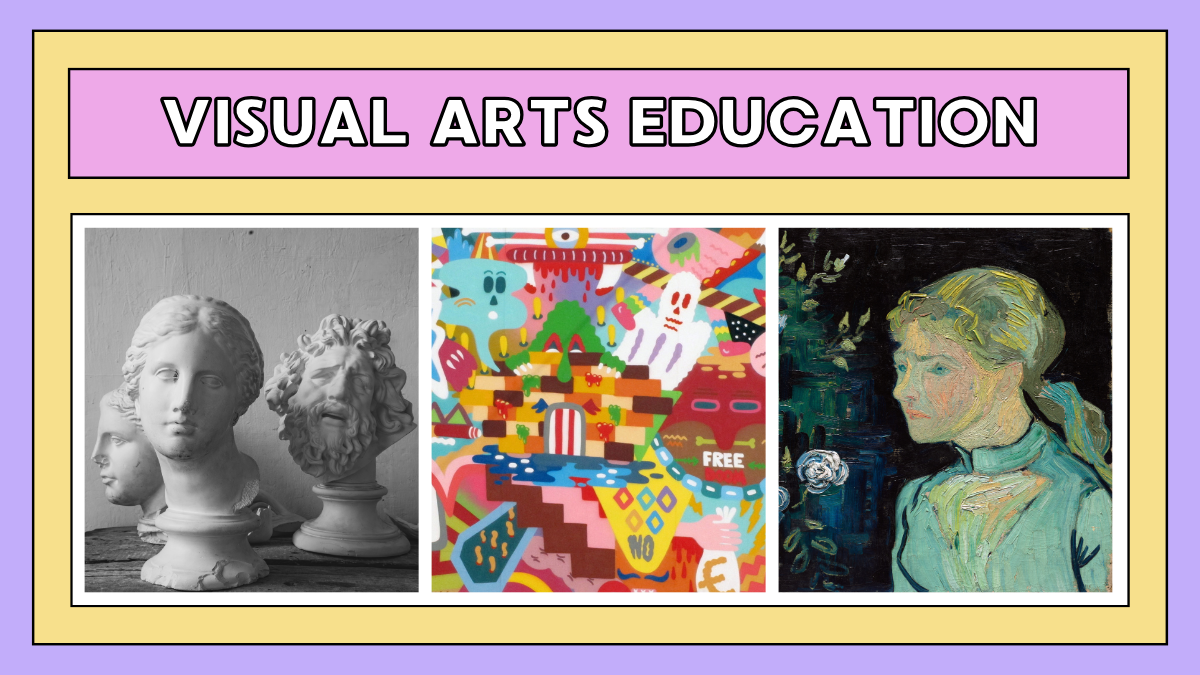
Introduction
Visual arts education plays a pivotal role in nurturing creativity and critical thinking among individuals. From drawing and sketching to digital art, it encompasses various forms of expression that foster personal growth and development. In this article, we’ll delve into the importance of visual arts education, its components, challenges, strategies for improvement, and its impact on individuals and society.
Table of Contents
Importance of Visual Arts Education
Enhancing Creativity
Visual education provides individuals with a platform to explore their creativity freely. Through experimentation with different mediums and techniques, students can unleash their imagination and develop unique artistic styles.
Fostering Critical Thinking
Engaging in visual arts encourages individuals to analyze, interpret, and critique both their own work and that of others. This process fosters critical thinking skills, enabling students to approach problems from multiple perspectives and develop innovative solutions.
Building Confidence
Creating art allows individuals to express themselves authentically, leading to a sense of accomplishment and self-confidence. Visual arts education provides a supportive environment where students can explore their talents and overcome challenges, boosting their self-esteem.
Components of Visual Arts Education
Visual education encompasses various disciplines, each offering distinct opportunities for artistic expression:
Drawing and Sketching
Drawing and sketching serve as fundamental skills in visual arts, allowing individuals to capture their observations and ideas through line and form.
Painting
Painting enables individuals to explore color theory, composition, and texture, translating their emotions and experiences onto canvas or paper.
Sculpture
Sculpture involves shaping and manipulating materials to create three-dimensional artworks, encouraging individuals to consider space, form, and structure.
Digital Art
Digital art leverages technology to create visually stunning artworks, blending traditional techniques with digital tools to push the boundaries of creativity.
Visual Arts Education in Schools
Incorporating arts education into school curricula is essential for providing students with a well-rounded education:
Curriculum Integration
Integrating visual arts into core subjects such as math, science, and history promotes interdisciplinary learning and enhances students’ understanding of complex concepts.
Extracurricular Activities
Extracurricular art programs and clubs provide opportunities for students to further develop their artistic skills and pursue their passions outside of the classroom.
Challenges in Visual Arts Education
Despite its importance, visual arts education faces various challenges that hinder its accessibility and effectiveness:
Funding and Resources
Limited funding and resources pose significant barriers to implementing comprehensive visual arts programs in schools and communities.
Perception of Importance
Misconceptions about the value of visual arts education may lead to its deprioritization in favor of subjects perceived as more “academic.”
Accessibility
Not all students have equal access to visual arts education, particularly those from underserved communities or schools with limited resources.
Strategies to Improve
Addressing these challenges requires collaborative efforts and innovative approaches:
Advocacy and Awareness
Raising awareness about the importance of visual arts education and advocating for increased funding and support can help ensure its inclusion in school curricula.
Collaboration with Communities
Engaging with local communities and cultural institutions can provide additional resources and opportunities for students to explore art outside of the classroom.
Utilization of Technology
Embracing technology allows educators to enhance visual arts education through virtual learning platforms, digital art tools, and online resources.
Impact of Visual Arts Education
Visual arts education has far-reaching benefits that extend beyond the classroom:
Academic Performance
Studies have shown that students who participate in visual arts education demonstrate higher academic achievement and improved cognitive skills.
Personal Development
Engaging in visual arts fosters self-expression, resilience, and empathy, contributing to individuals’ personal growth and well-being.
Career Opportunities
Visual arts education prepares students for a wide range of careers in fields such as design, animation, illustration, and fine arts, opening doors to diverse professional opportunities.
Impact of Visual Education
Visual Education has a profound impact on individuals and society as a whole, spanning cognitive, emotional, and social dimensions. Here are some key impacts:
Cognitive Development:
Visual education enhances critical thinking skills by encouraging individuals to analyze, interpret, and evaluate visual information. It fosters creativity and imagination, allowing learners to explore new ideas and perspectives. Through hands-on practice, students develop problem-solving abilities and spatial reasoning skills, which are valuable across various disciplines.
Emotional Expression:
Engaging with visual arts provides a platform for emotional expression and self-discovery. It allows individuals to communicate feelings, experiences, and beliefs non-verbally, fostering emotional intelligence and empathy. Artistic expression can serve as a therapeutic outlet, promoting mental well-being and resilience.
Cultural Understanding:
Visual arts exposes individuals to diverse cultural traditions, histories, and perspectives. By studying artworks from different societies and time periods, students gain insights into the values, beliefs, and aesthetics of various cultures. This fosters cultural appreciation, tolerance, and cross-cultural communication skills, promoting global citizenship.
Communication Skills:
Visual literacy, the ability to interpret and create visual messages, is increasingly important in today’s visually-oriented society. Arts education cultivates this skill by teaching students how to effectively communicate ideas, emotions, and narratives through imagery. This proficiency extends beyond traditional art forms to encompass multimedia, digital media, and visual storytelling techniques.
Social Development:
Collaborative art projects and critiques promote teamwork, communication, and constructive feedback skills. Visual education fosters a sense of community and belonging within classrooms and communities, encouraging peer interaction and mutual support. Participation in arts-related activities also enhances social confidence and leadership skills.
Career Opportunities:
Arts education prepares individuals for diverse career paths in fields such as fine arts, graphic design, advertising, architecture, animation, and education. It equips students with both technical skills and creative problem-solving abilities valued in the workforce. Moreover, arts education nurtures entrepreneurship and innovation, empowering individuals to pursue entrepreneurial ventures and creative enterprises.
Personal Growth and Fulfillment:
Engaging in the visual arts fosters personal growth and fulfillment by providing opportunities for self-expression, mastery, and accomplishment. Whether pursuing art as a hobby or a profession, individuals derive satisfaction from the creative process and the ability to communicate meaningfully through their work.
In summary, visual education enriches lives by fostering cognitive development, emotional expression, cultural understanding, communication skills, social development, career opportunities, and personal fulfillment. Its impact extends beyond the individual to contribute to a more creative, empathetic, and culturally rich society.
Future of Visual Arts Education
The future of visual education is likely to be shaped by several key trends and developments:
Integration of Technology:
As technology continues to advance, arts education will likely incorporate more digital tools and techniques. This could include virtual reality (VR) and augmented reality (AR) applications for immersive learning experiences, as well as digital painting and sculpting software.
Interdisciplinary Approaches:
There will be a growing emphasis on interdisciplinary learning, where visual art intersects with other fields such as science, technology, engineering, and mathematics (STEM), as well as humanities and social sciences. This approach fosters creativity, innovation, and critical thinking.
Global Perspectives and Cultural Diversity:
With the world becoming increasingly interconnected, visual arts education will embrace cultural diversity and global perspectives. Students will be encouraged to explore and appreciate art from different cultures, leading to a richer and more inclusive understanding of the world.
Environmental and Social Awareness:
There will be a greater focus on environmental sustainability and social issues within arts education. This could involve exploring themes such as climate change, social justice, and human rights through artistic expression, fostering empathy and activism among students.
Experiential Learning and Collaboration:
Hands-on, experiential learning will continue to be emphasized, with opportunities for students to collaborate on projects and engage with the broader community. This could involve partnerships with local artists, galleries, museums, and other cultural institutions.
Personalized Learning and Flexible Pathways:
Visual arts will increasingly cater to individual interests and learning styles, offering personalized learning experiences and flexible pathways. This may involve a combination of traditional studio courses, online learning platforms, workshops, and mentorship programs.
Professional Development and Entrepreneurship:
There will be a greater emphasis on preparing students for careers in the arts, including professional development workshops, networking opportunities, and entrepreneurship training. This will empower students to pursue careers as practicing artists, educators, designers, curators, and arts administrators.
Assessment and Evaluation:
Assessment methods in visual arts will evolve to encompass a broader range of skills and competencies, moving beyond traditional forms of evaluation such as exams and essays. This could include portfolio reviews, peer assessments, and project-based assessments that better reflect real-world artistic practices.
Overall, the future of visual arts education is likely to be dynamic and adaptive, responding to changing societal needs, technological advancements, and cultural shifts. By embracing innovation, collaboration, and inclusivity, visual arts education can continue to inspire creativity, critical thinking, and cultural enrichment in future generations.
Visit Website :- guest post buy
Also Visit :- Telegram
Conclusion
Visual arts education is not merely about learning to draw or paint; it’s about nurturing creativity, fostering critical thinking, and empowering individuals to express themselves authentically. By integrating visual arts into education systems and communities, we can unlock the full potential of individuals and enrich society as a whole.
How does visual arts education impact personal development?
Ans. Visual arts education promotes self-expression, resilience, and empathy, contributing to individuals’ personal growth and well-being.
What are the benefits of incorporating technology into visual arts education?
Ans. Incorporating technology into visual arts education expands access to resources, enhances learning experiences, and prepares students for careers in digital art fields.
What are some challenges in visual arts education?
Ans. Challenges in visual arts education include limited funding, misconceptions about its importance, and unequal access to resources.
How can schools improve visual arts education?
Ans. Schools can improve visual arts education by integrating it into curricula, providing extracurricular opportunities, and advocating for increased funding and resources.
Why is visual arts education important?
Ans. Visual arts education enhances creativity, fosters critical thinking, and builds confidence, preparing individuals for success in school and beyond.





